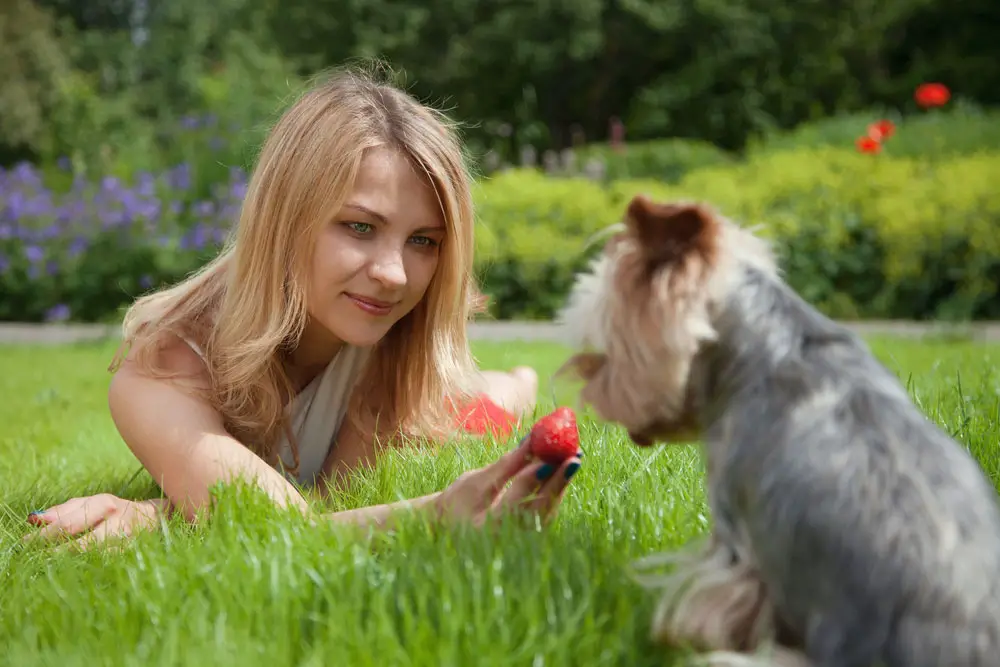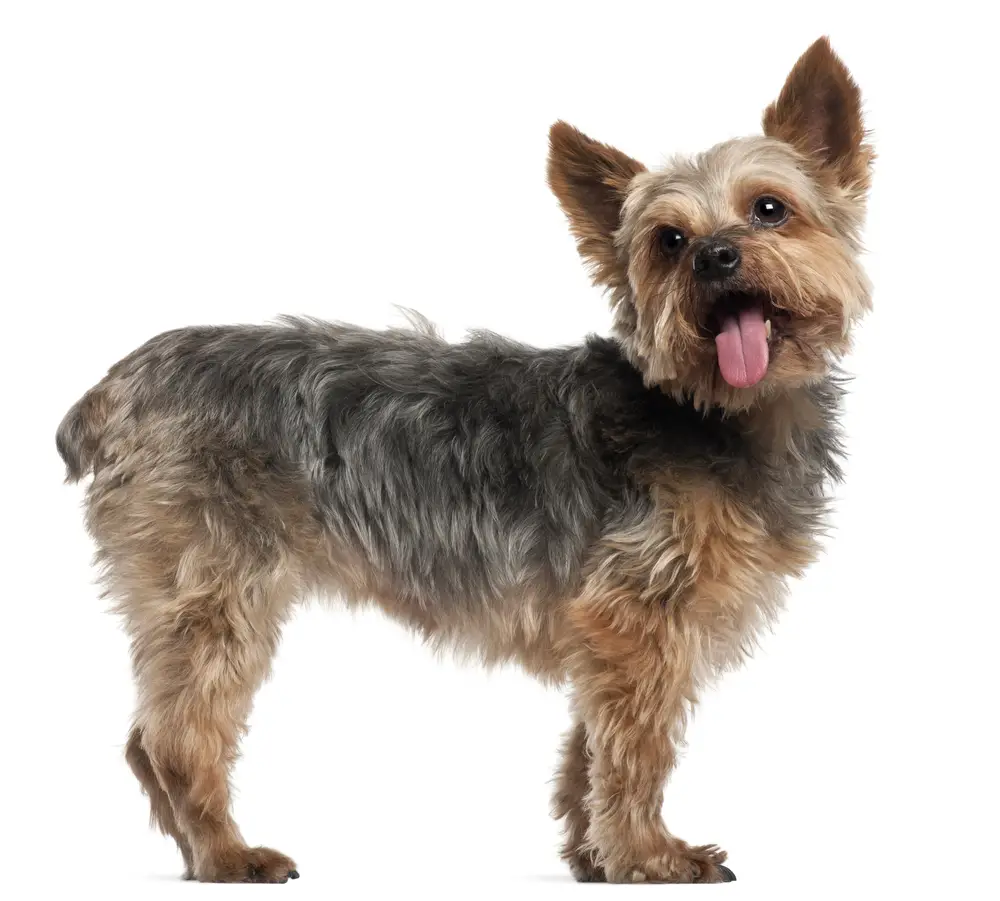Yorkie Allergies: Your Need To Know Guide
Yorkie Allergies: Your Need To Know Guide
When it comes to dealing with human allergies, Yorkshire Terriers are usually the number one dog of choice. They have hypoallergenic coats, and as a result, they do not shed as much as longer-haired dogs, or other breeds. While that may be great news for dog owners seeking a suitable pet, it is of little consolation to those who may still find themselves suffering from allergies your beloved Yorkies themselves.
What Causes Yorkie Allergies?

Courtesy of Braden Detelich
Just like with humans, allergies in our canine companions are caused by triggers – offending substances which your dog comes into direct contact with. These are usually ingested, inhaled or come into direct contact with the coat.
Causes can be varied and hard to pin down and can range from normal household items and fabrics, detergent, carpets, cleaning solutions, and air fresheners, to plants, grass, pollen and weeds, dust mites, insect bites and allergic reactions to fleas. Chemicals are another common culprit, along with certain plastics and rubbers, smoke, and even certain foods – including your dogs own food.
Contact allergies mean that your dog has a sensitivity to something they have physically come into contact with, such as a shampoo or grooming product. If the allergy is seasonal or environmental, it means that your Yorkie is reacting to something in the environment – similar to the way in which humans suffer from hayfever.
Culprits may be pollen, dust, smoke or mold. Food allergies can be the most simple – your dog will be reacting to a food, or to an ingredient or additive in the food. These are usually chemical preservatives designed to help the food last and keep fresh for longer, or common issues around grain, wheat, corn, eggs or soy.
Insect allergies can be very serious for the tiny size of Yorkies, and are an almost constant threat during the summer months. If your dog develops an allergy to wasp, bee or ant stings, they risk going into anaphylactic shock. This will target the gastrointestinal and cardiovascular systems and, in the worst-case scenario, can result in death.
Just like with humans, it can be hard to find out the exact cause of your pets allergy, and your vet may try out a range of solutions to help identify the root.
This may involve removing certain triggers one at a time and observing the results – for example, you may be asked to stop using a certain cleaning product or air freshener, or change the detergent you use to wash your clothes. If you suspect that food is the issue, you may have to keep a strict food diary which details everything your dog eats over a certain period of time, and monitor any ill effects which may occur. You may then need to eliminate a food at a time until you see a reaction, and this will help you to narrow down the possible suspects until you find a solution.
What Are The Symptoms?

Courtesy of Randi Rothstein
Seeing your pet in pain or discomfort is a horrible experience, and it can be hard to tell the difference between an illness or under-the-weather period, and an ongoing allergy.
The most common signs that something is amiss is itching, though this may initially be mistaken for fleas. Skin problems may develop, such as itchy patches, rashes, and hives, flaking skin or bald spots, or you may notice your dog worrying at a certain spot more often.
The skin may be hot to touch, and you may start to notice hair loss in certain spots. Some pooches will also chew on their feet or rub their face on the furniture to alleviate their discomfort or start showing excessive attention to a certain area that is irritating them. Over the top licking of a single spot is a sign that they are uncomfortable, and can also contribute to hair loss.
Physical symptoms of allergy may manifest as ordinary illnesses, such as recurring ear infections which don’t seem to shift, even with antibiotics. A bloodshot or teary, irritated eye can also be a sign of an allergy and will cause discomfort for your pet. Issues with digestion, such as constant vomiting or diarrhea are also common and need to be addressed quickly to reduce the risk of dehydration.
More serious symptoms can also present, such as issues with respiration and breathing. If you notice your dog struggling with shortness of breath, strange coughs, and sneezes, wheezing, a stuffy nose or congestion, you should seek advice from your vet as soon as possible. Your dog may also be snoring loudly or more regularly than before, and this could also be a sign that something is up.
Yorkies are small dogs with tiny lungs, so if you notice any trouble with breathing you need to get your pet to a vet immediately. This is also the only course of action if you discover a weakened or erratic pulse or a heart rate which has suddenly increased. Pale gums and fever are major red flags, and if any extremities feel cold, or your dog collapses, you also need urgent and emergency treatment.
What Are the Treatment Options?
 If you suspect that your Yorkie is suffering from allergies, you should seek a vet who will help you to diagnose and understand the problem, and help to advise with the best treatment options. There are a number of solutions you can try, and these involve both medical and non-medical options.
If you suspect that your Yorkie is suffering from allergies, you should seek a vet who will help you to diagnose and understand the problem, and help to advise with the best treatment options. There are a number of solutions you can try, and these involve both medical and non-medical options.
Avoidance
In the case of a mild allergy, or one with a clear and simple cause and trigger, simple avoidance may be an option to help avoid symptoms and clear up any health issues which have occurred.
The first step is to determine the cause and trigger of the allergy, as we have discussed above, You can ask your vet for help and advice with this, and the answer may an easy change of food or bedding. Some of the most common allergies and avoidance techniques include:
Changing the flooring
 It may sound strange, but carpets can be crafted from fibers which are common triggers for Yorkie allergies. In addition, the harsh and bristly texture will make any symptoms feel worse and cause discomfort. Change your carpet for a wooden floor, or use a large, spacious dog bed for your pet to sleep on, and have clear areas where they can be free of the carpet.
It may sound strange, but carpets can be crafted from fibers which are common triggers for Yorkie allergies. In addition, the harsh and bristly texture will make any symptoms feel worse and cause discomfort. Change your carpet for a wooden floor, or use a large, spacious dog bed for your pet to sleep on, and have clear areas where they can be free of the carpet.
Cleaning products and chemicals or detergent
Cleaning products are another common cause of most allergies and can be rectified by simply switching to another product. Be aware that the allergy can be to an ingredient in the solution, so take care when you choose your alternative. In addition, washing your dog’s bedding, blankets and towels with a strong detergent may cause an allergy which irritates the fur. This can be resolved by changing to another washing solution.
Toys and bowls
We hate to think we have done anything to inconvenience our pets, but good intentions can have unforeseen consequences. Any cheap plastic or rubber toys can be a trigger, as can anything which has strong, heavy coloring. These tend to be cheaper in price and can result in an allergic reaction which usually manifests itself around the mouth. Avoid this by removing all toys if you see signs of an allergy, and investing in approved, high-quality toys from reputable pet retailers.
In a similar vein, cheap plastics used for food and water bowls, or those labeled as PVC, BPA or phthalate free can cause allergies. This is usually displayed by itching and irritation on the face and mouth where contact has been made. The best bet is to use stainless steel or ceramic bowls – though a little more expensive, these are far less likely to trigger irritation or allergy.
Grooming products
Shampoos or other grooming products are common causes of allergic reactions. Many will contain a strong, heavy perfume, foam boosters such as cocamide DEA or MEA, or preservatives. Using a natural, organic product is a good way to help prevent this and make sure you test all products on a small amount of the coat and leave for 24 hours before using all over your Yorkie. You can find more Yorkie shampoo recommendations here
Food
Food is a very common factor in triggering allergies, and it is important to notice this as early as possible. There are two main types of allergies here – those where the dog is allergic to the actual food, and one where it is an ingredient or additive which is causing the reaction.
Even natural products such as eggs, poultry, grains or even protein can be allergens, though the most common causes are synthetic preservatives which make the food cheaper to produce and distribute. It is not only main foods which can be an issue – snacks and treats should also be monitored closely for signs of a reaction. Common signs will include digestive issues, rashes, sores and itches, though any change in appetite and temperament should be noted and monitored carefully.
If you suspect that your Yorkie is suffering from a food allergy, you should first of all seek the advice of your vet. They will usually recommend a food diary, where you monitor everything your dog ingests – this is easier said than done with curious pooches!
 This gives you a clear list of all foods and their reactions and should make it easier to narrow down a suspect. The next step is usually to eliminate everything but the plainest and simplest foods from the diet, adding things in slowly one at a time until a reaction occurs.
This gives you a clear list of all foods and their reactions and should make it easier to narrow down a suspect. The next step is usually to eliminate everything but the plainest and simplest foods from the diet, adding things in slowly one at a time until a reaction occurs.
Using these two techniques together will help you identify the issue, and you can take steps to alter your pet’s diet as necessary. It can take between 8 and 12 weeks for a difference to show, so be prepared to commit long term to any changes you make, and continue thorough monitoring during this period.

Lincoln and Diesel – Courtesy of Kim Garrod
Symptoms from food allergies can be nasty, and risk leading to longer-term issues if left untreated. Some of the most common symptoms include vomiting and diarrhea as your pet tries to expel the allergen from their body, and this can cause severe dehydration.
Make sure you offer your Yorkie water constantly and encourage them to take regular sips to ensure that their hydration levels remain consistent. It is a good idea to withhold food for 12 hours to allow the stomach to settle, and reintroduce plain substances such as lean beef, sweet potato, and chicken without the skin for a few days to prevent a recurrence.
To reduce the risk of an allergy resurfacing, make sure you stick to natural, organic food and treats – you can even cook your own pet food if you want total confidence and control over what they are taking into their bodies.
Airborne Particles
Another common cause of allergies is airborne particles resulting from pollen, trees, grasses, molds, and weeds. Depending on your location, this may only be an issue for a few months of the year, and in this case, the allergy can usually be managed with medication or by avoiding the offending items.
If the culprit is present all year, it is trickier to manage. Start by removing all items from your home and yard which could cause an issue, such as offending trees, any weeds, o plants which produce large amounts of pollen.
You can also take steps to reduce symptoms with every walk. Apply a good-quality paw wax once a week – this will help prevent your pet from picking up allergens or spores on their paws and bringing them home to irritate them.
Hypoallergenic wipes can also be useful for wiping down their coats every time they come inside. Whether they have enjoyed a marathon alk or simply headed out to greet the postman, they will pick up pollen and other allergens on their fur – a hypoallergenic wipe helps make sure as much as possible stays outside. You can also rinse paws straight under a tap, and make sure you only take a walk when the pollen counts are lower to minimize discomfort.
Household irritants
It is hard to avoid allergens which are outside the home, but containing those which share a space with your pet can seem almost impossible. As we have mentioned, changing cleaning and laundry products is a great start, but airborne allergens from dust and dust mites can be a real cause of misery for your dog.
Dust mites tend to live on top of surfaces but have been known to burrow into soft furnishings. Their droppings then cause horrible allergies for both people and Yorkies and can be hard to contain.
A HEPA air purifier can be a great solution in these situations and can have a significant reduction in the number of rogue particles in the air. They work by absorbing pollen, dust mites and other airborne particles which can cause an allergic reaction. They can be added into the central air system, or purchased as a portable stand-alone model. Not only will your Yorkie’s symptoms reduce, but owners will also benefit from improved, clear air quality.
In addition, damp dusting can be a big help in keeping the levels of dust manageable and preventing it from moving dust mites around, lifting them into the air to spread around the house. Dampen down your duster before using to lift and remove the dust and their mites.
You should also make sure that all new mattresses are covered in protectors with allergy-proof qualities to reduce the issue, and vacuum your mattresses and dog beds regularly to reduce the risk.
All bed linen – including the dogs – should be washed weekly along with toys, blankets, towels and clothes – and needs to be heated to a hot wash of at least 140F to kill dust mites. Finally, removing footwear before entering the home, and requesting that guests do the same, can be a big help in reducing the particles which enter your home.
Topical Sprays
There will come situations where avoidance alone is not enough, and further treatment is required. In these instances, your vet will usually prescribe topical sprays. There are a range of choices, depending on the type and severity of the allergy.
Hot spot spray
These are used when the skin is hot, swollen, irritated or red, and can offer a soothing feeling and solution which will prevent dogs being tempted to lick or chew at the area – this often causes further damage to an already affected area. Look for something with chamomile, aloe vera or tea tree for the best results. Find one with aloe here.
Medicated anti-itch spray
Some symptoms manifest as itching, and this can be very painful. An anti-itch spray will cool down the affected area and alleviate the itchy sensation while healing the skin at the same time. These tend to contain hydrocortisone and lidocaine, which can work together to prevent itching and reduce redness and inflammation.
For a natural solution – some Yorkies have allergies to chemicals – try something with oatmeal, baking soda, and wheat germ. Any spray should also ideally contain Vitamin A to fortify skin cells, Vitamin D to repair damaged skin and Vitamin E for antioxidants.
How Can I Prevent A Recurrence?

Molly – Courtesy of Lesley Houser
Once you have got to the root of the allergy, and determined the triggers, causes, and best treatments, there are steps you can take to help reduce the symptoms or prevent your pet from being affected by the same allergen.
The most important consideration is consistency – it is crucial not to stop any treatments or preventative measures once the symptoms seem to have got better. Remember, the itching may have stopped, and food may be kept down, but your Yorkie is still allergic to the trigger, and could show new symptoms at any time is they are exposed. It is a good idea to get into the habit of regular maintenance to keep your pooch as healthy as possible despite their allergy.
Make sure you keep a firm, clear schedule to keep your house as allergen-free as possible, and your Yorkie clean. List any essential chores, such as damp dusting or vacuuming mattresses and couches, and how often. Remember to include daily chores such as wiping down your Yorkie after walks, or applying paw wax. Leave copies of the list in easy-to-spot places, and get into good habits. It is also a good idea to ensure that you are always stocked up with essentials, such as hypo-allergenic wipes, paw wax, dusters, any sprays or lotions, and any medication given by the vet. Better to have too much to store than for your pooch to suffer.
As well as keeping your house and routine in tip-top shape, make sure you are regularly grooming your pet to keep their skin and coat healthy. They should have regular baths, with a medicated shampoo if needed, and be groomed and brushed regularly to prevent matting, encourage circulation and keep follicles super healthy. Keeping the coat and skin in good condition will help you to manage any allergic reactions better, as well as offer a chance to check in and notice any changes. If your pet is prone to allergies, also remember to take care before introducing any new chemicals or substances into the home – there is every chance that new allergies could develop.
Conclusion
Keeping your Yorkie healthy and happy is a number one priority for any pet owner, and the good news is that this can be achieved even if your precious pet suffers from allergies. Whether a reaction to a food or a real hatred of your brand new carpet, there are solutions and tips which can make your dog’s life easier and more comfortable, with minimal effort on your part.
With a little care and attention, and a slight tweak to everyday routines, you can keep your pooch fit and well, and allow them to continue to enjoy long walks, lots of playing, and plenty of fuss and cuddles without worrying about them suffering a reaction. Those owners who are allergic to dogs are blessed to find a little hypoallergenic Yorkie to love, but remember to look after them in return, and reduce their stress and suffering as much as possible: your pooch is definitely worth the effort.

